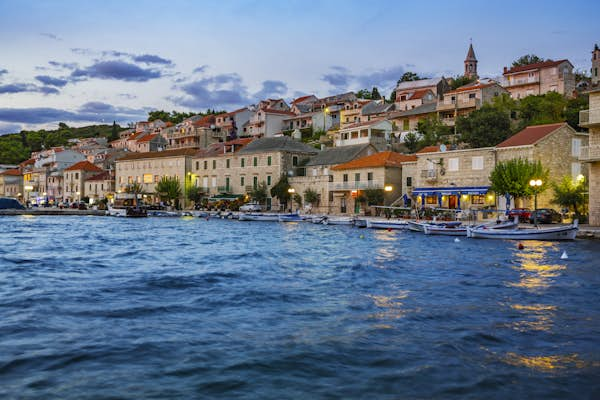Brač may be one of many when it comes to islands off the Croatian coast, but this Dalmatian island is unmatched when it comes to natural beauty and must-visit attractions.
Beaches of fine white pebbles ribbon its coastline, and cycling paths and hiking trails crisscross the island, passing through age-old villages, lush olive groves, and neat rows of vineyards. Dotting the coast are charming fishing villages offering a taste of the local way of life that carries on once the last tourists have gone.
Zlatni Rat Beach
Croatia’s most famous beach, the long, thin, V-shaped Zlatni Rat (Golden Horn), pokes into the sea off the south coast of the island. Framed by a ring of turquoise water set in the brilliant aquamarine of the Adriatic, and carpeted with fine white soft pebbles, it looks just as magnificent in real life as it does on Instagram. The beach’s unique tail-like shape magically shifts with the tide and currents of the Adriatic, changing its outline. The steady summer breeze on the eastern side of the beach makes it a draw for windsurfers and fans of kitesurfing.

A pleasant one-mile stroll along a pine-scented coastal path brings you to Bol, a tiny port town that turns on the charm at night. Candles and fairy lights flicker on restaurant patios where you’re unlikely to find a table without a prior reservation, especially at hotspots like Konoba Mali Raj, Taverna Riva, or beachside Ribarska Kućica.
Vidova Gora

Looming above Zlatni Rat is the 2552-foot high Vidova Gora, the highest peak in the Adriatic islands. It’s a strenuous two-hour hike uphill from Bol, or a challenging mountain bike ride for those who prefer traveling on two wheels. But if you don’t want to sweat it, there’s no need: you can easily reach the peak by car. Whichever way you make it to the top, you’ll be rewarded by sweeping seascapes, the beautiful sight of neighboring Hvar island, and a birds-eye view of Zlatni Rat beach below.
Blaca Hermitage

Just west of Vidova Gora, hidden away on the rocky slopes of a deep remote ravine, is the 16th century Blaca Hermitage. The hermitage started as a cave sheltering a group of priests and monks fleeing the Ottomans in 1551. After living here for 400 years, they left behind a small complex of four interconnected white stone buildings where they had their residential quarters and a church.
It’s hard to imagine how the monks planted olive groves and vineyards in such difficult terrain, but they successfully cultivated these crops and exported 70,000 liters of wine a year to Venice. The former hermitage building now houses a museum showcasing some of the relics they left behind: mostly religious artifacts, but also astronomical equipment and a piano hauled all the way up here from Vienna.
Blaca Hermitage can only be reached on foot along a rocky path. Follow the signs from Vidova Gora, and you’ll come to the walking path leading down to the hermitage, a 30-minute hike. Another option is to travel by boat to Blaca Valley and make the 30-minute climb uphill.
Olive oil museum in Škrip
The olive tree is one of the perennial symbols of Brač, and a testament to its centuries-long history of olive cultivation. Over one million olive trees dot the island landscape and many local producers have won international awards for their high-quality extra virgin olive oil.
Learn all about the history of olive production and the traditional pressing process at the Olive Oil Museum in Škrip, the oldest village on the island. The museum is run by the Cukrov family, and set in a former 19th century olive mill occupying a rustic stone house. Here you can see a huge stone press and tools once used for pressing olives before machines replaced this traditional method.

Don’t leave before sampling the family’s award-winning extra virgin olive oil, and if that piques your appetite, order one of the tasting menus. There are table olives and black and green tapenade to be savored, as well as other delights produced on the island: jams of fig or bitter orange, Brač cheese, Dalmatian cured ham, and local red wine.
Pučišća Stonemasonry School
Another natural resource Brač is famous for is the limestone that has been quarried here since Roman times. The Romans and Venetians used Brač limestone to build many of Croatia’s architectural gems, including Diocletian’s Palace in Split, Šibenik’s St. James’ Cathedral, and St. Lawrence’s Cathedral in Trogir, all UNESCO World Heritage sites.
In 1906, the picturesque town of Pučišća, located on a sleepy inlet off Brač’s north coast, was chosen as the site for a training center for stonemasons. 50 years later, the Klesarska Škola Pučišća (Stonemasonry School of Pučišća) opened its doors. Follow the tapping sound of chisels hitting stone to a handsome sea-facing building of white Brač stone (naturally) to see students busy at work, using only traditional hand tools. A light-filled room on the ground floor is an exhibition space showcasing some of the graduates’ best work sculpted from the island’s signature stone.
The fishing villages of Milna, Sutivan, Splitska, and Postira

For a glimpse of island life and a taste of Dalmatian’s relaxed vibe, head to one of Brač’s sleepy fishing villages. Milna on the west coast has a long horseshoe-shaped harbor where you can have breakfast at a sea-facing cafe while watching the fisherman come in with their catch.
Perched on the northwest coast is lovely Sutivan, a compact town of old stone houses and flower-filled gardens. You’ll find a similar atmosphere further east, in Splitska and Postira. A coastal walking path links these two tiny seaside villages, bookended by beaches that lure sun worshipers- there’s no better spot to truly soak up the Mediterranean island atmosphere of the island.
